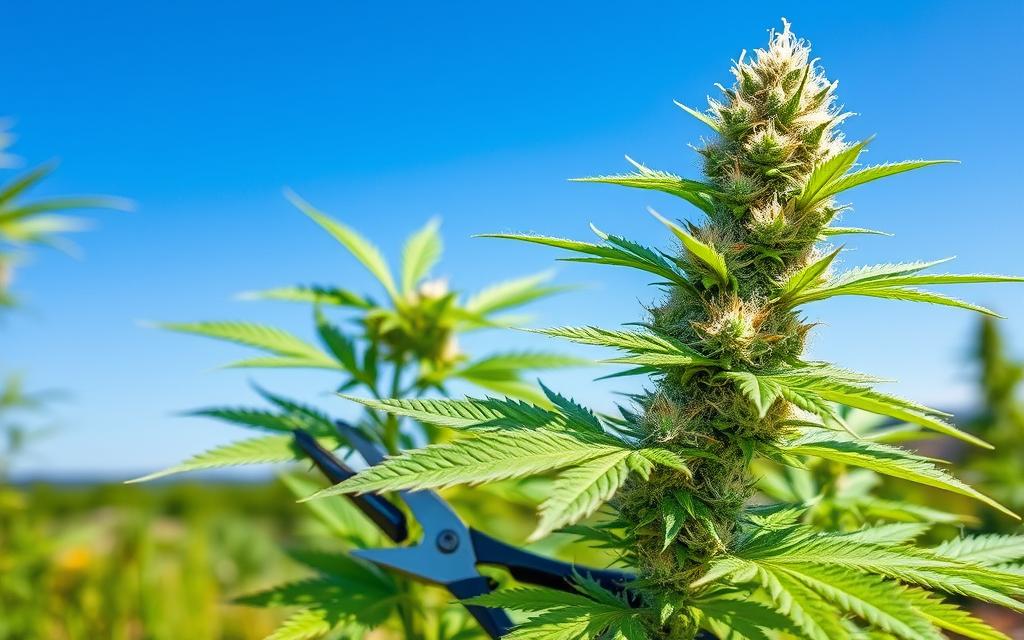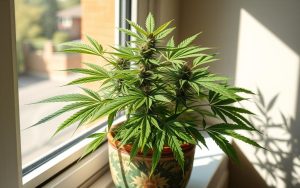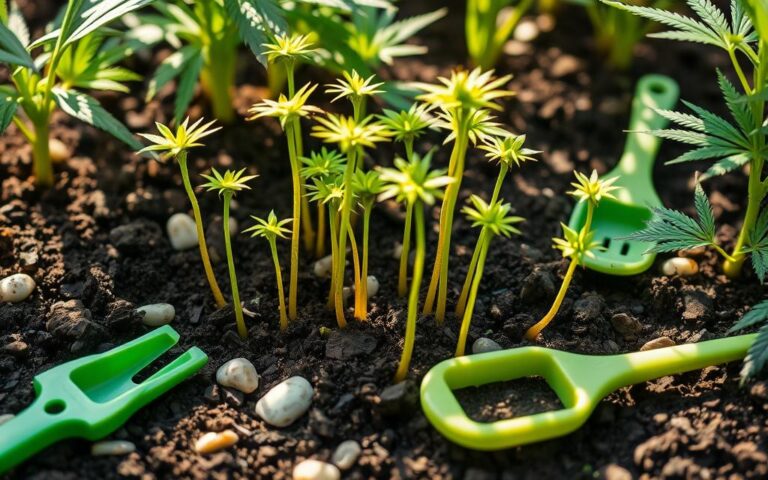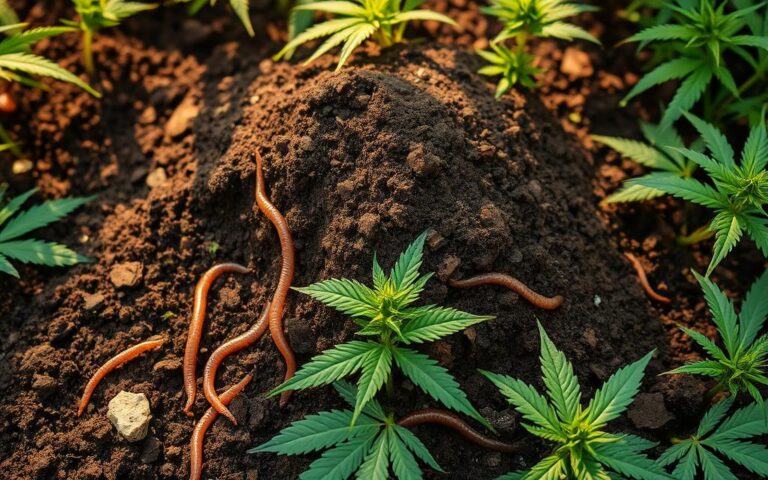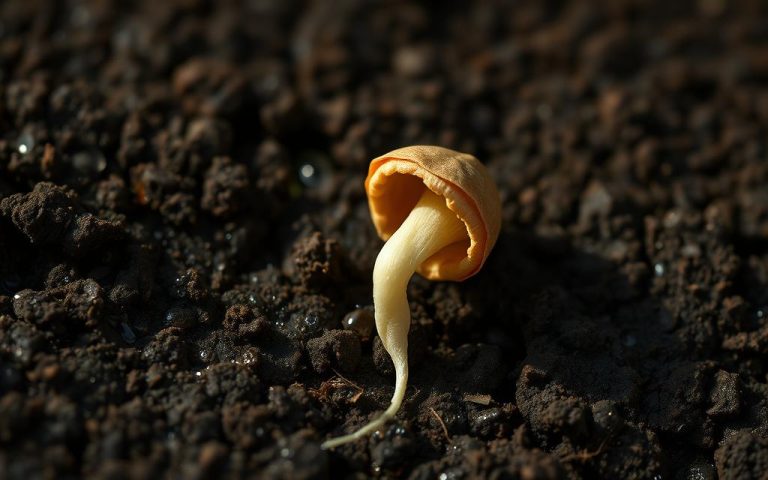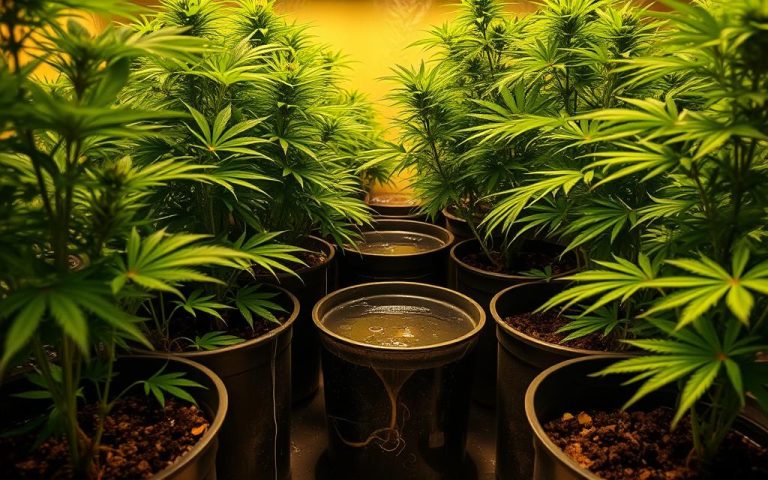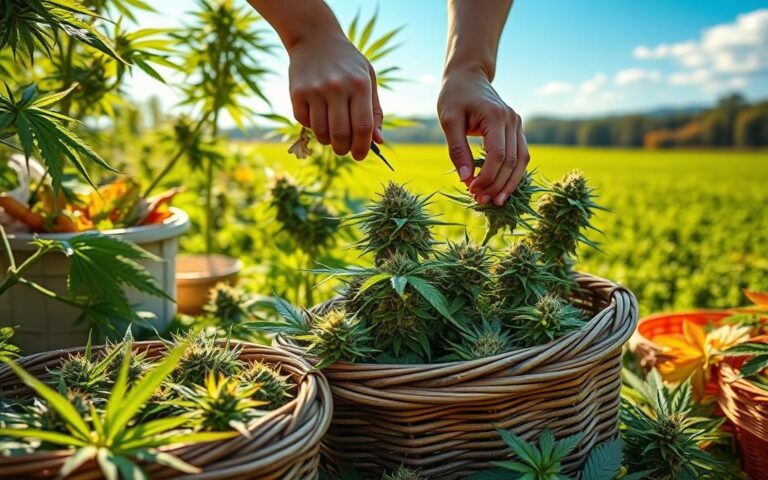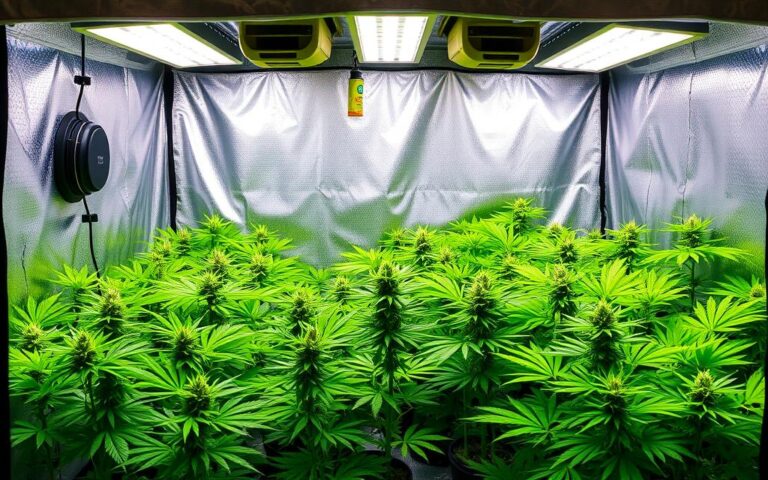How to Harvest Autoflowering Cannabis Plants
Harvesting cannabis autoflower plants is crucial, affecting the quality and potency of your yields. It’s key for growers to know about autoflowering cannabis, as these plants can be ready in 45 to 70 days. Getting the timing right is essential for high THC levels.
This guide covers the essential cannabis harvesting techniques. These techniques help enhance your crop’s yield and flavour. You will also learn about flushing and other methods for the best results. With effort and knowledge, your autoflowers can produce abundantly, showcasing their full potential.
Understanding Autoflowering Cannabis
Autoflowering cannabis plants are a big step forward in how cannabis grows. They switch from growing to flowering without needing a change in light. This characteristic comes from their Ruderalis ancestors. These plants usually go from seed to harvest in 8 to 12 weeks. This speed makes them popular with growers who want fast results.
These plants stand out because they can grow with very little darkness. They do well with 18 to 24 hours of light each day. This lets growers tailor the light to suit their needs perfectly.
Knowing how autoflowers grow is key to getting a good yield and strong plants. When they’re just seedlings, they like moist conditions. But as they start to flower, they prefer less humidity. This helps avoid problems like mould.
The right temperature, between 20 to 25°C, is also important. It’s all about finding the right conditions to make autoflowers thrive.
Thanks to modern breeding, autoflowering strains are tougher against pests and diseases now. Their quick growth and strength make them appealing to new and experienced growers alike. For fast harvests or high quality, these strains are a great choice.
Why is Flushing Important Before Harvesting?
Flushing cannabis plants greatly improves the quality of the buds. This step involves watering the plants with pH-balanced water. It has no nutrients and happens about two weeks before harvest. This lets the plants get rid of excess nutrients. As a result, the cannabis buds are smoother and taste better.
Benefits of Flushing
Flushing makes the cannabis taste and smoke better. It clears out unneeded nutrients, so the plants use what they’ve stored. Well-flushed cannabis has a smooth taste, burns evenly, and leaves light grey ash. On the other hand, if it’s not flushed well, the smoke can taste bad and leave dark ash.
- Improves taste and aroma of the buds
- Reduces harshness during smoking
- Increases the overall quality of the final product
- Helps in nutrient lockout resolution
Flushing Periods for Different Growing Methods
The time needed to flush cannabis depends on the growing method. Soil growth needs about 10 to 14 days. If you’re using hydroponics, a shorter period of 2 to 3 days is enough. Coco-coir setups need between 4 to 7 days to flush properly.
| Growing Method | Recommended Flushing Period |
|---|---|
| Soil Growing | 10 to 14 days |
| Hydroponic Cannabis | 2 to 3 days |
| Coco-Coir | 4 to 7 days |
When to Harvest Autoflowering Cannabis Buds
Knowing when to pick autoflowering cannabis buds is key for top-level strength and quality. Growers check the pistil colour change and trichomes status to see how mature the cannabis is. These methods give important clues, making sure the final product is great in taste and impact.
The Pistil Technique
The pistil technique is a tried-and-tested way to tell when it’s time to harvest. Autoflowering cannabis’s white pistils turn to dark brown or red as they mature. It’s best to harvest when about 60-70% of the pistils have changed. This indicates that the buds are at their highest cannabis potency.
Watching these changes helps us understand the plant’s growth from the fifth week to full bloom around the seventh week.
State of the Trichomes
Checking trichomes is vital to decide when the buds are ready. These tiny parts make cannabinoids and terpenes, affecting the cannabis’s strength. The colour of the trichomes, clear or cloudy white, shows if THC levels are at their highest.
Amber trichomes mean more CBN, providing a calmer effect. Harvesting when you see both clear and amber trichomes can offer a well-balanced experience.
Tools like a jeweller’s loupe or a USB microscope help a lot in seeing trichomes closely. This detailed check is crucial for the harvest timing and helps your plants reach their maximum potential.
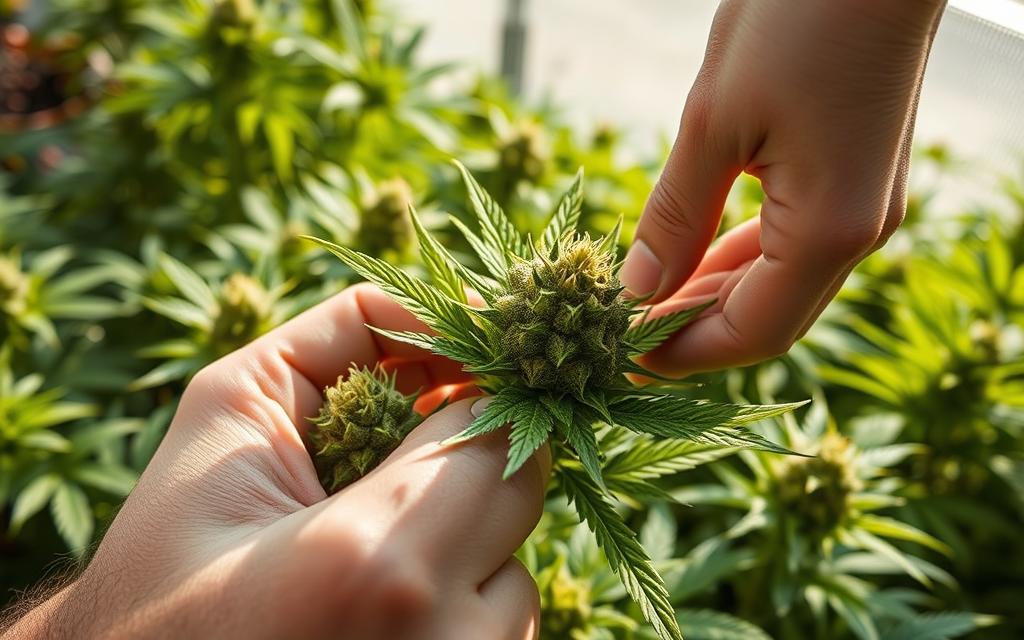
| Trichome Colour | Effect | Optimal Harvest Timing |
|---|---|---|
| Clear | Head high, lower potency | Not recommended, unripe |
| Cloudy | Peak THC, balanced effects | Ideal harvesting range |
| Amber | More sedative high | Preferred for relaxing effects |
How to Harvest Cannabis Autoflower
Harvesting autoflower cannabis needs a careful approach for top-quality outcomes. It starts with a series of cannabis harvesting steps. First, flush the plants to enhance the flavour and smoke’s smoothness by getting rid of extra nutrients. After the flushing period, cut the plants carefully to protect the buds. Remove any supports before cutting at the base. Then, take the plants to a trimming area to prepare the cannabis buds further.
Step-by-Step Harvesting Process
For successful autoflower harvest, follow these steps:
- Flush the plants based on your growing method:
- Soil Cultivation: 10 to 14 days
- Coco-Coir Cultivation: 4 to 7 days
- Hydroponic Cultivation: 2 to 3 days
- Look at the pistils; it’s time to harvest when 60-70% have darkened.
- Clear away any supports before cutting cleanly at the base.
- Then, move the plants to a trimming area.
Trimming Techniques: Wet vs Dry
The choice between wet trimming and dry trimming affects the quality of your cannabis. Each method has its benefits:
| Trimming Method | Benefits | Considerations |
|---|---|---|
| Wet Trimming | Lowers mould risk and quickens drying | Needs immediate trimming after harvesting |
| Dry Trimming | Keeps aroma and flavour better | Makes leaves brittle, so handle with care |
Both wet and dry trimming prepare buds well for drying and curing. Choose based on your environment and preference for the best harvesting autoflower results. For more tips on harvesting, visit this resource.
Proper Drying Techniques for Your Buds
Ensuring your cannabis dries properly is key. After cutting, how it dries affects its quality and strength. The right techniques keep off mould, keep the smell, and make sure it’s safe to store. It’s important to watch the temperature and humidity. You also need to stop mould from growing as it dries.
Temperature and Humidity Control
The best drying room stays at about 21°C (70°F). It should also have a humidity around 50%. In these conditions, it takes about four to seven days to dry. This time frame stops mould and keeps the taste and strength. Slow drying for at least seven days makes the smell, taste, and cannabis compounds even better. It’s crucial to keep an eye on humidity with RH meters for the best drying.
Avoiding Mold During Drying
It’s vital to watch for cannabis mould while it’s drying. Always check for mould, especially if humidity changes a lot. Drying buds upside down in a dark place helps them dry evenly. Don’t blow air directly on them, as it can dry them unevenly. To be extra safe from mould, use moisture meters to know when they’re ready for the next steps.
| Parameter | Ideal Conditions | Recommended Duration |
|---|---|---|
| Temperature | 21°C (70°F) | 4-7 Days |
| Humidity | 50% | Monitor daily |
| Mould Prevention | Regular inspections | Throughout drying |
| Drying Techniques | Upside down, dark room | 7+ Days for optimal effects |
If you follow these drying methods, your cannabis will keep its high quality. This sets you up for successful curing and a top-notch final product.
The Importance of Curing Your Cannabis
Curing your cannabis follows the drying phase and is key to boosting both taste and strength. It’s important to cure in the right conditions. Use glass jars filled to three-quarters and store them somewhere cool and dark. This method greatly enhances how your cannabis is kept.
Keeping the humidity between 60-65% helps break down chlorophyll gently. This process makes smoking smoother and extends the shelf life. When done right, cannabis can stay fresh for over a year, retaining its lovely smell and taste.
Creating the Right Environment
To cure cannabis well, keep a stable temperature between 20-22°C. This protects the cannabinoids and stops them from breaking down. At the start of curing, open the jars daily for 10 to 15 minutes. This lets in fresh air and lets you check for mould.
As weeks pass, you can open the jars less often. The usual curing time is between three to eight weeks. However, some might cure for up to six months to ensure top quality.
Burping and Monitoring During Curing
When curing cannabis, keep it away from light, heat, and too much air. These can harm the quality of your buds. Aim for a humidity level of 62%. This process not only reduces sugars and starches but also improves smell and taste.
Mastering curing means better smoking experiences and showcases your hard work in growing. For more tips on harvesting and curing, check out this resource. Or, follow the latest cannabis trends via this informative blog.

